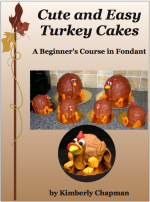Last weekend I attended the 2013 Frosting Creators of San Antonio Day of Sharing and decided to do some further gummy experiments with the excuse of entering a piece into their “Born in the USA” themed contest.
I wanted to find out the following:
1) Could I get a translucent white gummy, as in, not use the Opaque recipe but somehow use the Clear recipe without resorting to adding white food colouring, which clumps up and makes speckles?
2) Could I cast gummy directly onto plexiglass instead of doing the more labour-intensive Flexible, Edible Stained Glass methodology of creating sheets, drying them, cutting them, and fusing them?
3) What would happen to the gummy cast directly onto the plexiglass as it dried? Would it be stuck to the plexiglass enough to keep it in place, or would it eventually curl the glass or split apart?
Thus, I made the US flag in gummy, figuring I probably wouldn’t win anything in the competition but that it was good impetus to answer those questions.
First, I sized a graphic of the US flag to the width of my plexiglass, which I got inexpensively as part of a poster frame from Target. I had some printing issues but managed to get the stars section and enough of the stripes that I could then use a ruler on the paper that came in the frame to draw out the rest of the lengths.
While prepping some blue Basic Gummy and warming/cooling it several times over for optimal clarity, I clipped one of the frame sides on to keep the gummy from flowing over the side and used Simi Flex Form Molds (which I recently reviewed here) as dams on the other three sides, held down with small fondant buckets especially along the frame clip to ensure there was no leaking.

The Simi silicone strips stick to the plexiglass well, but I used tubs just to be sure that joins and overlaps were pinched tight.
Then I used a baster to carefully apply the blue gummy into that space.

See those blue drips in the upper left corner? Whenever I do gummy work, I make an effort to approach with the baster from an angle where drips will matter the least. Sometimes there aren’t any drips, but if there are, you don’t want them to land on your actual work surface or other portions of your piece if you can avoid it. Although the stained glass ebook does cover how to recover from such a mishap, should it happen.
I let it set up on the kitchen table for a very long time (mostly because I had to go pick my kid up from school) and then removed the strips and the side clip carefully to reveal a lovely blue rectangle:

Any slight remnants were easily trimmed off with an x-acto blade, and otherwise this was perfectly aligned on my printout.
Next I used a star cutter as close as possible to the size of the stars on my printout. This would have been easier if I’d done it when the gummy was still freshly poured and just solid, but because as mentioned above I had to pick up my kid, take her to karate, come home, make dinner, get her to bed, etc., it was evening before I got to cutting and the gummy was really solid. I had to push the cutter down fairly hard and give it a wiggle each time to cut through (which probably scratched the plexiglass but I didn’t mind since I was only using it for this project and the seams would hide those scratches). On that first hole, you can see some ragged edges because I didn’t cut down far enough and had to go in with an x-acto blade to remove the star. After that, I cut harder and they came out more cleanly.

By the second last column of stars, my thumb was bruised from pushing on the little cutter and I thought of Grandpa Simpson.
Next is where that first question came into play: how could I get a white gummy that wasn’t the Opaque recipe (because I thought opaque would be too harsh against the translucency of the red and blue, and half the point of doing stuff in gummy is the translucency)? I still need to write a separate post all about the speckling that occurs when you add white food colouring to gummy, but I knew that that wouldn’t work. So I tried an experiment of adding a tiny bit of milk to the Clear recipe. It worked! After a few experiments, I decided that two teaspoons of milk to a single batch of Clear was the right level of white for what I wanted. I then carefully filled in each star hole with that result, letting the beads of liquid rise a little above the holes to help ensure there was enough to settle into the pointed ends of the stars without leaving gaps.

These puffs did flatten out a bit as they firmed up and dried.
Then I lined up some of the Simi strips along the lines on my sketch, pushing them up against the blue field, and put one of the frame’s side clips on the other side to once again help contain the gummy as it flowed.

I took the time to write R and W in every stripe on my guiding diagram because when you’re working closely on a piece and getting tired, it’s far too easy to make a mistake. Always build in extra safeguards against silly errors, especially the kinds of errors that will offend people.

The key when filling a trench like this is to go in a smooth, steady motion and let the flow of the gummy push its way along. Remember that you can use your baster to suck up any bubbles that come out, and be sure not to overfill the area or it will flow over the far side. You want to put enough in there that it makes a thick piece that wells up against that side clip without bulging over.
Then it’s simply a matter of working your way down, letting each stripe solidify and then using one of the Simi strips to make a dam for the next one.

This was a fairly easy project at this point: cast, go do something else for half an hour, repeat.

Progressing down the stripes.
It is important to mention that the plexiglass does flex under the warmth of the gummy, even when you let it cool down substantially. You can see in the photo below how the flexing created highs and lows in the stripes, and if you look at the blue section you can see that it’s lighter in the middle because it’s thinner there. I thought this might happen but wasn’t worried about it, and as the piece progressed and the “waves” lined up with each other naturally, I decided it was a good look for a flag. But this might not be so good if you wanted it to be perfectly even, so keep that in mind.

You can somewhat combat this by paying close attention as your filling the trench and adding a bit more gummy to the thin spots, but that can usually just flow along anyway so you can only do so much about it. If this will ruin your piece, don’t cast directly onto the plexiglass; use the more standard techniques shown in the Flexible, Edible Stained Glass book instead.
When I got to the longer stripes below the blue field, I had to use two Simi flex mold strips end-to-end because the longest is 21″ and I was making a 24″ wide flag. But my earlier tests had shown that they were pretty good about not allowing leaks, and even when a bit dribbled through it would self-plug the hole as it set up, so I wasn’t too worried.

End-to-end Simi Flex Molds on the wider part of the flag. No leak! These really are great products for this sort of thing. They’re made for isomalt but work very well for gummy.
When it was all done and very definitely set up, I took it outside for some sunlit photos. I wish I had a way of suspending it against the clear blue sky, but this was the best I could do because our neighbourhood has so many lovely tall trees:

Behold the gummy glory of Old Glory!

A direct view.

Detail of the stars which actually sparkled in the sun quite nicely.
The reason I put it on plexiglass was so that it could be mounted in a curved fashion on a stand at the actual show and I could write on the information sheet that judges are invited to bend it to see how incredibly flexible it is. I did that for the Lady of Shalott piece for the Austin show in 2012 but the judges there didn’t understand and actually knocked points off for the plexiglass. Thankfully in San Antonio they understood and later told me they thought that was a cool aspect of the presentation.
In fact I guess they really dug it, because they gave it first place in the Special Techniques category! And this was in the Masters division! I entered it at that level because the way their show writes the rules, I guess I’m a master of gummy since I’m the only one who has done this much work with it and put out a book on the subject. I didn’t expect to win anything, though. And to be really fair, it was the only piece in its category and division that was on-theme. Still, I’ll happily take that pretty blue ribbon!

Ooo, shiny!
Now for the bad news: remember my question above about what would happen as the gummy dried? The answer is it splits apart at the joins. It actually had started to do this by the morning of the show, which was frustrating. By the time I got around to making this post a week later, several deep splits had shown up:

This is the most recent split, which I noticed yesterday, about a week and a day after creation.

This split was there on the Sunday morning of the show, a few days after creation. It hasn’t gotten any bigger, though.

Some splits at the side started showing up through the day during the show and have been slowly getting worse since. That makes sense since they’ll be drying out the most with the increased surface exposure on the ends.
So what does all of this mean? Summed up, you can cast pieces directly onto plexiglass for a short-term display and they will fuse together, but you need to be aware that as they dry, the fused edges will start to pull apart in random places. I could have cast this whole thing on the plexiglass in one day and then carefully removed it to form one whole piece, then laid it back down or put it on something else and that would have relieved some of the tension from the drying, especially if I repeated that a few times. But remember that I likely scratched the plexiglass when cutting the stars and trimming the sides of stripes, so if I’d lifted it and put it back down, those hidden scratches may have become more apparent.
You could, of course, make a piece like this on a food-safe super-smooth mat and then wrap it around a cake (in this case, a very large cake). You could even allow it to drape and fold like thick cloth, and the fused joins should stay together fine as long as they’re not stressed in any way, including as they dry further.
Just be aware that you can’t make a long-term piece of large pieces fused together unless you allow for drying and shrinkage, or the fuses will pull apart.
Here’s to hoping some of you make something cool for the 4th of July with this information. Maybe it’s time to do something other than a blueberry, strawberry, and whipped cream cake this year? Why not make a cake, cover it with white buttercream, and make a small flag out of gummy and lay it right on the buttercream? That’ll impress your friends and family to be sure!
And yes, despite becoming a US citizen last year I am still also a Canadian citizen. I could make a giant gummy Canadian flag, but it’d be much trickier to cast those two big red stripes and then a vast white field in the center. Then I’d have to cut out the maple leaf and fill that area with red, right up into each of the eleven pointy corners and do it as evenly as possible. That’s harder. If someone nearby holds an event where I have an excuse to do it, though, I will…












You never fail to amaze me!!